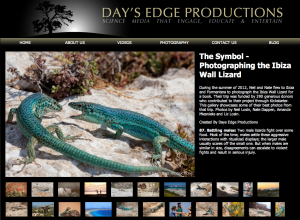
Click this image to check out our fourth photo gallery!
Our expedition to photograph the Ibiza Wall Lizard has come to an end! None of us can believe how quickly it flew by. We are sad to be leaving this place, but we feel confident that we’ve taken all the photos we need to put together a beautiful and engaging book about this incredible lizard species. Click here, or on the thumbnail image, to view a fourth photo gallery from our trip.
Since our last gallery, we’ve visited seven new island populations. The first was Isla Malvin Nord, which hosted brilliant green lizards with bright orange bellies. Next we checked out the lizards on Dau Gran, a truck-sized rock off the cost of Ibiza Town. The population of lizards on Dau Gran are the result of intentional mixing; before the 20th century, there were no lizards on this tiny island. In 1930, the German biologist Eisentraut brought 20 green female lizards from Ibiza (Podarcis pityusensis pityusensis) and 8 black male lizards from Escull Vermell (Podarcis pityusensis maluquerorum) to this small rock to see what would happen if these populations mixed. Over the last 80 years, these two subspecies have interbred and produced an amazingly unique population of lizards that show clear characteristics from both original populations. Check out the photo gallery to see some images of this experimental population.
We left Formentera on Saturday the 14th. Over the next five days we visited populations in and around the west coast of Ibiza. The first island we visited during this trip was also the hardest island to reach. On Sunday the 15th, we set out to visit the majestic island of es Vedra. Es Vedra, an island off the southwest coast of Ibiza, is off-limits to the general public. It is an iconic location in the islands and has inspired legends for centuries. Many people say that es Vedra, which stands almost 400 meter out the sea, is the tip of the lost city of Atlantis. Others say it is the location where Odysseus was seduced by the Sirens. There are even legends, both recent and centuries old, that the island is a UFO landing site. There is something about the island that draws you in. From the moment we arrived in Ibiza and Formentera, we’ve wanted to visit this island.

A watch tower overlooks the islands of Vedranell (in the front) and es Vedra (the larger island).
We are producing a short film about our adventure to es Vedra, so I wont give away too many details. I will say this, though: our trip to Vedra was the most epic day of our expedition. To get there and back, we swam four miles, hiked for seven hours and managed to take some photos in between. We can’t wait to share our film about this trip, so stay tuned.
The next two days after es Vedra, the National Parks had a boat available to take us out to some new islands. During that time, we visited Espartar and Esparte – two islands that are separated from one another by less than 10 meters, yet have astonishingly divergent lizard populations. The last island we visited was Conillera, a large island near the Ibizan town of San Antonio, with a great view of all the western islands.
After over a month of photographing lizards on dozens of islands, we realized that we had forgotten something important – we didn’t have any photographs of the Ibiza Wall Lizard in Ibiza! And so, we spent the last day of our expedition capturing images of the Ibiza Wall Lizard on the island where they got their name.
While our photographic journey may be over, our work has just begun. We have countless photos that need editing and several videos about our expedition that we’ll to share with you over the next several weeks. As soon as these are ready, we’ll let you know!
To see our first three photo galleries go here:
Gallery 1
Gallery 2
Gallery 3













